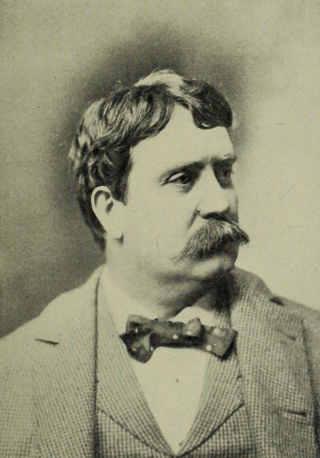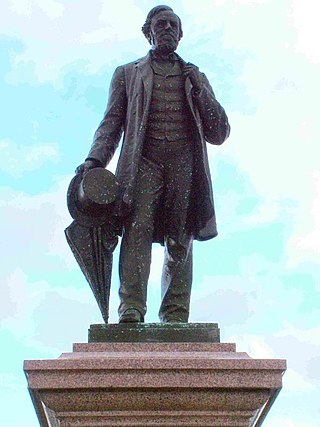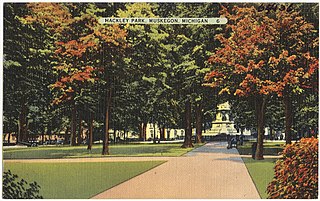
Daniel Hudson Burnham was an American architect and urban designer. A proponent of the Beaux-Arts movement, he may have been, "the most successful power broker the American architectural profession has ever produced."

Kenosha is a city in the U.S. state of Wisconsin and the seat of Kenosha County. Per the 2020 census, the population was 99,986 which made it the fourth-largest city in Wisconsin. Situated on the southwestern shore of Lake Michigan, Kenosha is a satellite city within the greater Chicago metropolitan area as defined by the U.S. Census Bureau. Kenosha is located about halfway between Chicago and Milwaukee, and Interstate 94 connects Kenosha to both metropolitan areas.
The year 1900 in architecture involved some significant events.

Graceland Cemetery is a large historic garden cemetery located in the north side community area of Uptown, in Chicago, Illinois, United States. Established in 1860, its main entrance is at the intersection of Clark Street and Irving Park Road. Among the cemetery's 121 acres (49 ha) are the burial sites of several well-known Chicagoans.

Charles H. Durkee was an American pioneer, Congressman, and United States Senator from Wisconsin. He was one of the founders of Kenosha, Wisconsin, and was a Governor of the Utah Territory in the last five years of his life.

Charles Henry Niehaus was an American sculptor.
Ossian Cole Simonds, often known as O. C. Simonds, was an American landscape designer. He preferred the term 'landscape gardener' to that of 'landscape architect'. A number of Simonds' works are listed on the U.S. National Register of Historic Places (NRHP).

Zalmon Gilbert Simmons Sr. was a businessman, manufacturer, Wisconsin legislator, and mayor of Kenosha, Wisconsin.

The Bradford Community Church, originally the Henry M. Simmons Memorial Church and later the Boys and Girls Library, is a historic church built in 1907 in Kenosha, Wisconsin, United States under the leadership of Kenosha's first woman pastor.

Kemper Hall is placed on a Kenosha County park with 17.5 acres in Kenosha, Wisconsin, United States. Kemper Hall overlooks Lake Michigan with a historic chapel, observatory, the Anderson Arts Center, and the Durkee Mansion.

The Gilbert M. Simmons Memorial Library is located in Kenosha, Wisconsin, United States, and is a location of the Kenosha Public Library (KPL). KPL consists of 4 locations, an Outreach department, and is a member of both the Kenosha County Library System (KCLS) and the SHARE Consortium. The Simmons Memorial Library was added to the National Register of Historic Places in 1974, and was the first formal location for KPL. KPL was named the Power of Libraries Award Winner in 2018, Wisconsin Library Association's 2020 Library of the Year, and a finalist for the National Medal for Museum and Library Service in 2021.

The Library Park Historic District is a historic neighborhood in Kenosha, Wisconsin, United States, surrounding Library Park, which was originally conceived as a New England-style town commons. The district consists of 42 contributing properties built from 1843 to 1930. The district was added to the National Register of Historic Places in 1988.

The College Hills Historic District is a 67-acre (27 ha) residential historic district in Shorewood Hills, Wisconsin that was listed on the National Register of Historic Places in 2002. It includes architect-designed homes by Purcell and Elmslie and other architects among its 114 contributing buildings. Among them is the Prof. Philip M. and Marian Raup House.

The Civic Center Historic District is a group of six large Neoclassical Revival buildings around Civic Center Park in Kenosha, Wisconsin, United States, reflecting the city's history as Kenosha County seat.

Lake Forest Cemetery is a rural cemetery in Lake Forest, Illinois, United States. The site was first identified for burial in 1857 when the town of Lake Forest was planned. Later, William Le Baron Jenney designed a winding road system and Ossian Cole Simonds developed the landscape scheme.

The statue of George Palmer stands in Palmer Park, in Reading, Berkshire. The statue, by George Blackall Simonds, was unveiled in 1891, though it was originally in Broad Street and only later moved to Palmer Park. The statue has been classed Grade II Listed monument since 14 December 1978.

The Muskegon Historic District is a public and residential historic district in Muskegon, Michigan, consisting of the four blocks between Clay Avenue, Webster Avenue, Second Street, and Sixth Street, and the two blocks between Webster Avenue, Muskegon Avenue, Second Street and Fourth Street. The district was placed on the National Register of Historic Places in 1972.

Oak Hill Cemetery is a rural cemetery located in Cedar Rapids, Iowa, United States. It was listed as a historic district on the National Register of Historic Places in 2013. At the time of its nomination it consisted of 17 resources, which included 13 contributing buildings, one contributing site, two contributing structures, and one contributing object.

Hackley Park is a municipal park in Muskegon, Michigan. In 1890, it was built on land donated by Charles H. Hackley to honor the memory of soldiers who fought in the Civil War. It is bounded by Clay & Webster, and Third & Fourth in the Muskegon Historic District near Muskegon Lake.



















